Friedrich Krantz, 1856 - 1926
by Brian Stevenson
last updated September, 2018
The business of Dr. F. Krantz was, and still is, one of the world’s top suppliers of geological microscope slides, specimens, educational materials, and related supplies (Figures 1-5). The business was founded in 1833 by Friedrich’s uncle, August Krantz (1808-1872), as “A. Krantz”. After Friedrich earned his Ph.D. in geology, in 1888, he joined the Krantz business, and purchased it from August’s son-in-law in 1891. It was then renamed “Dr. F. Krantz, Rheinisches Mineralien Contor" (Rhenish Mineral Office). The company still operates under that name.
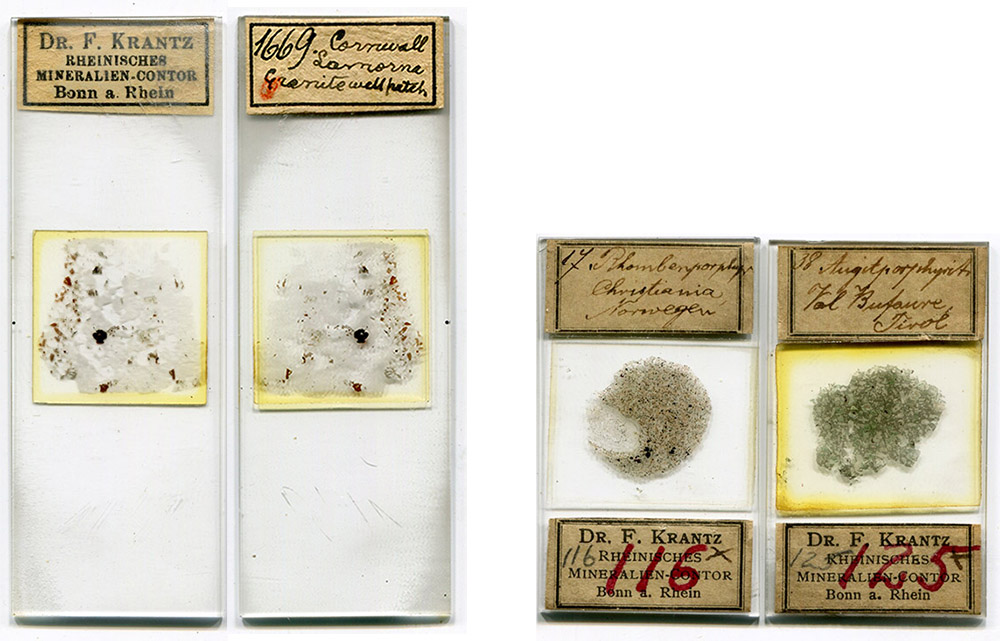
Figure 1.
Three microscope slides of thin-sectioned minerals, by “Dr. F. Krantz, Rheinisches Mineralien Contor”. The business adopted that name in 1891, and it is still used today. The mount on the left is on a standard-sized slide (1x3 inches). The label is pasted to the back of the slide, such that the maker’s name and address are visible when viewing the specimen, and the description of the object is handwritten on the reverse side. The two slides shown on the right are more frequently encountered, and are smaller than standard (1 7/8 x 1 1/8 inches , 48 x 28 mm) - these dimensions were commonly used for mineral specimens by many preparers throughout the world.
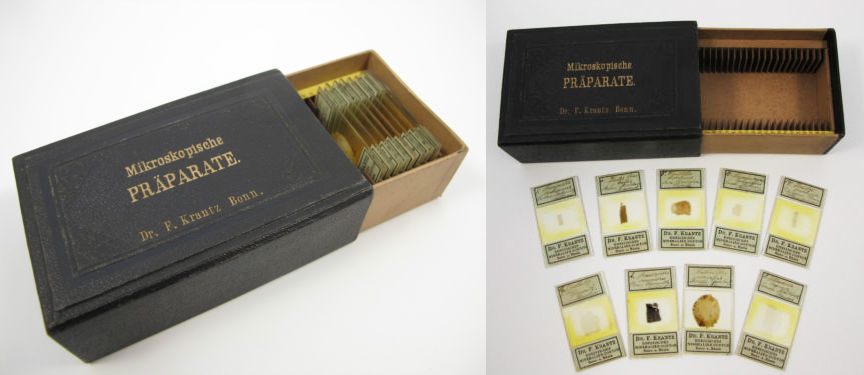
Figure 2.
A case of small microscope slides from Krantz. Adapted for nonprofit, educational purposes from an internet auction site.
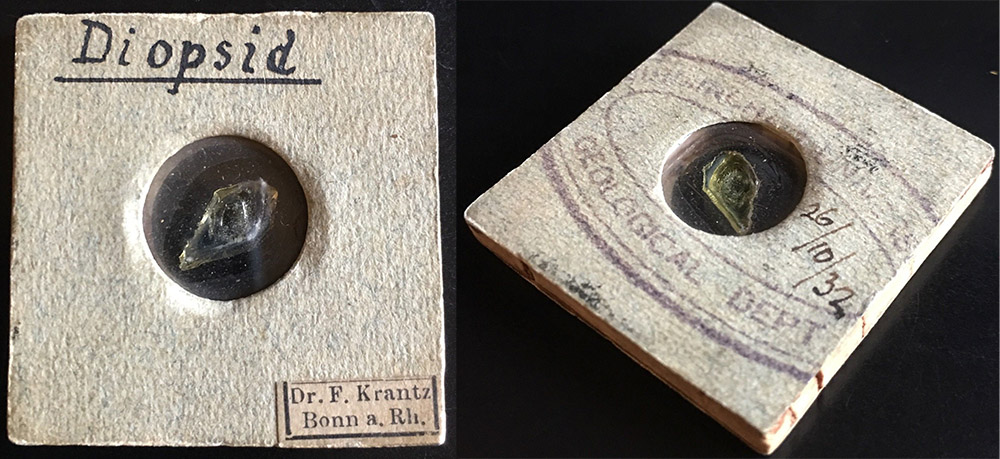
Figure 3.
An F. Krantz mount of a piece of diopside mineral. The reverse has a handwritten date of 1932. Adapted for nonprofit, educational purposes from an internet auction site.
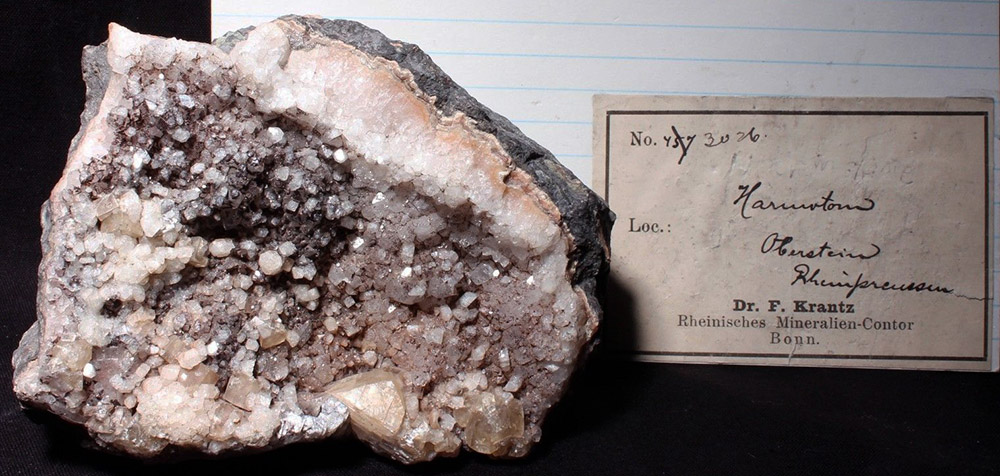
Figure 4.
An F. Krantz mineral specimen. Adapted for nonprofit, educational purposes from an internet auction site.
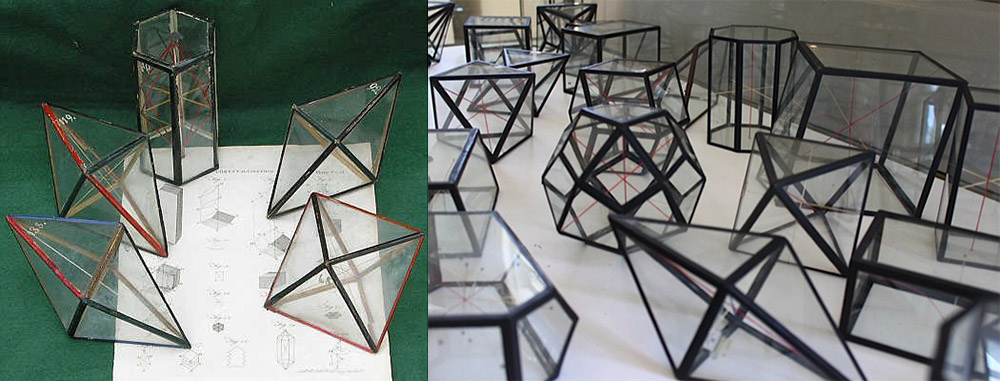
Figure 5.
F. Krantz glass models of crystal forms, for educational materials. Adapted for nonprofit, educational purposes from https://medium.com/designscience/crystal-models-5fed8679289f.
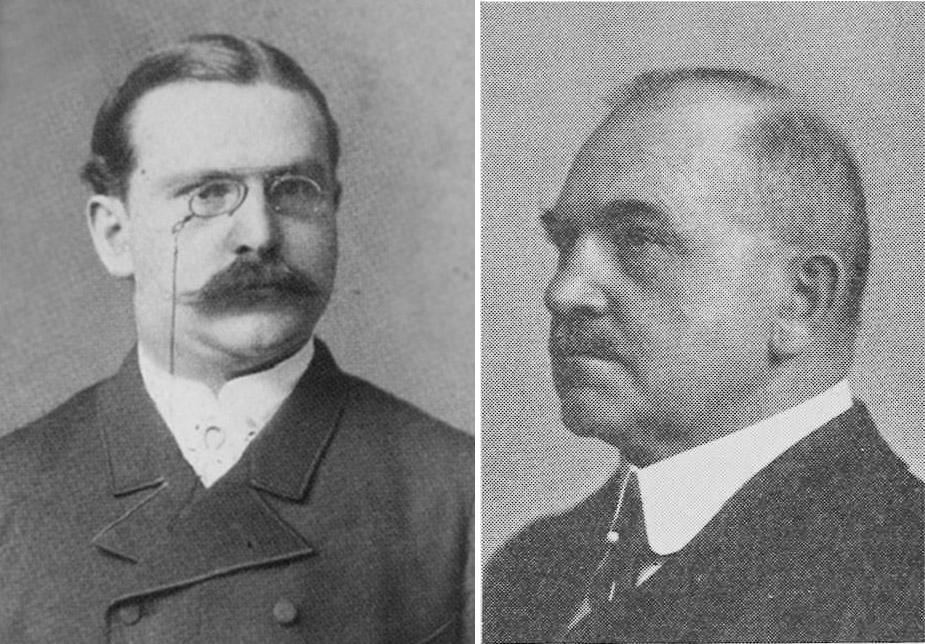
Figure 6.
Friedrich Krantz. Left, undated photograph, adapted from his company’s web site, https://www.krantz-online.de/en/ueber_uns/historie.html. Right, A 1923 photograph, adapted from Spencer, “Biographical notices of mineralogists recently deceased”,.
August Krantz opened his mineral supply business in Freiberg, on December 14, 1833. In 1837, he moved to the Prussian capital, Berlin. His business grew substantially in that center of science, and he sent employees across Europe and North America in search of specimens. Krantz moved to Bonn in 1850, probably to facilitate connections with the renowned Earth Sciences Department of the University of Bonn (Figure 6).
August Krantz died in 1872. He was memorialized in The Geological Magazine, “We regret to have to record the somewhat sudden death of Dr. August Krantz, of Bonn-on-the-Rhine, who died from an attack of erysipelas during a visit to Berlin on the 6th April last. Dr. Krantz of Bonn represents one of the longest established and most able members of that rare class, a scientific merchant in rocks, fossils, and minerals - one, who not only knew accurately the commercial value of his collections, but was intimately acquainted with the scientific worth of every specimen which passed through his hands. Indeed, there are few museums which have not been enriched from his cosmopolitan repository. He leaves an immense and valuable collection both of Minerals and Fossils, the result of the labours of a long life devoted to these pursuits. Dr. Krantz was in his 62nd year. We believe it is the intention of Madame Krantz to carry on her husband's business, with which she is well acquainted”.
The Krantz business was managed for the next 16 years by August’s son-in-law, Theodor Hoffmann. He was not trained in geology, and so relied upon the assistance of others to keep the scientific aspect on track. Substantial help was provided by Carl Hintze (1851-1916), a trained geologist who had largely given up scientific research due to eye problems. Hintze left Krantz in 1884 to become a Professor at the University of Bonn, and, in 1892, at the University of Breslau.
Friedrich Krantz was born in Glogau, Silesia on October 1, 1859. He studied chemistry and pharmacology in Freiburg, mineralogy under Carl Hintze, and received his Ph.D. in 1888. He joined the Krantz business that year, and purchased it in 1891. He then changed the name from “A. Krantz” to “Dr. F. Krantz”.
His entry in the 1896 “Naturalists’ Directory” reads, “Krantz, D.F. Rheinisches Mineralien-Comptoir u. verlagbuchhandlung, Coblenzerstr. 121, Bonn (Established 1833). Min., Paleo., Petrog., Offers Min., Meteo., fossils, rocks, thin sections of rocks, crystal models in wood and table glass, gypsum models of rare fossils, etc. Detailed price lists sent on application. Desired to purchase rare minerals and fossils from all parts of the world or to ex. for others”.
Friedrich died in 1926. Two years later, L.J. Spencer summarized his life and works, “Krantz (Friedrich Ludwig Robert) [1859-1926], the well-known mineral dealer at Bonn, was born at Glogau in Silesia on October 1, 1859, and died on March 12, He studied chemistry and pharmacology at Freiburg in Baden and took the degree of Ph.D. at Erlangen in 1888 with a dissertation on the crystallography of some organic compounds (Zeits. Kryst. Min., vol. 14, pp. 456-478), this work having been done under Prof. C. Hintze at Breslau (sic). He was a nephew of Dr. August Krantz (1809-1872), who founded the firm of Krantz in Berlin in 1838, removing to Bonn in 1850. The firm has supplied specimens, apparatus, and models for the study and teaching of mineralogy and geology to museums, universities, and colleges all the world over. Numerous fine mineral specimens have been supplied for the British Museum collection ever since 1838, and in 1859 a special crystal collection numbering 2,624 specimens was acquired. After the death of Dr. A. Krantz in 1872 the business was carried on by his son-in-law Theodor Hoffmann, and during that period Carl Hintze, afterwards professor at Breslau, was for a time in the employ of the firm. Dr. F. Krantz, joined after taking his degree in 1888, and since 1891 the business has been carried on under his name. Combining business ability with scientific knowledge he considerably extended the business, and removing to new quarters in Bonn some fine buildings were erected. Detailed catalogues of special collections prepared in collaboration with well-known experts were issued, and collectors were maintained in various countries. In addition to the crystallographic work mentioned above, Dr. F. Krantz wrote on thorium minerals in connexion with incandescent gas-lighting (1896) and on the development of the Upper Silesian zinc industry (1911). He was elected a member of our Society in 1907. Mrs. Krantz helped in the business during the difficult period of the war, and with this experience she has been able to carry on since the death of her husband - again with the help of a nephew”.
The business continued through the turmoil of the 1930s and World War II, under the management of Friedrich’s widow, Olga Krantz, and their nephew, Fritz Krantz. Olga died in 1948. Fritz died in 1974, whereupon his daughter, Renate Krantz, took over.
The business of “Dr. F. Krantz” still operates in Bonn. Minerals, models, and other items can be purchased through their web site, https://www.krantz-online.de/en/home.html. They are even on Facebook: https://www.facebook.com/Dr.F.Krantz.
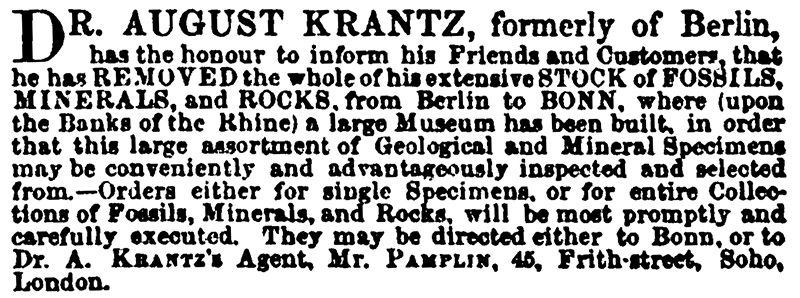
Figure 7.
An 1851 advertisement from “The Athenæum” (London), alerting customers to August Krantz’s 1850 move from Berlin to Bonn. Krantz had a sales agent in London for many years.
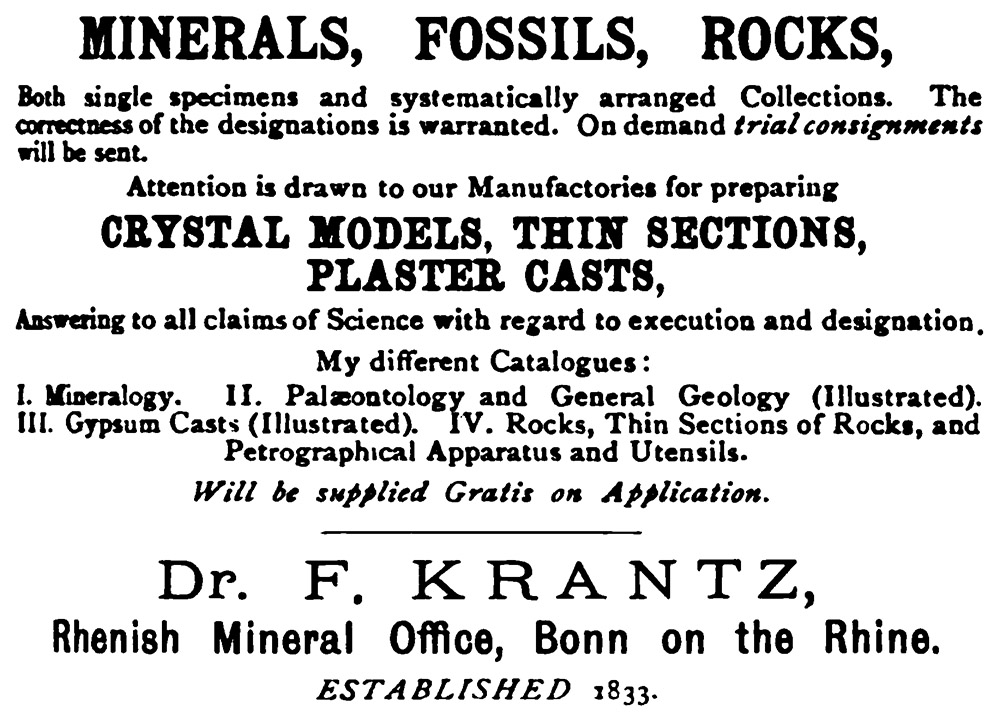
Figure 8.
An 1894 advertisement, from “Nature”. The advertised thin sections were microscope slides.
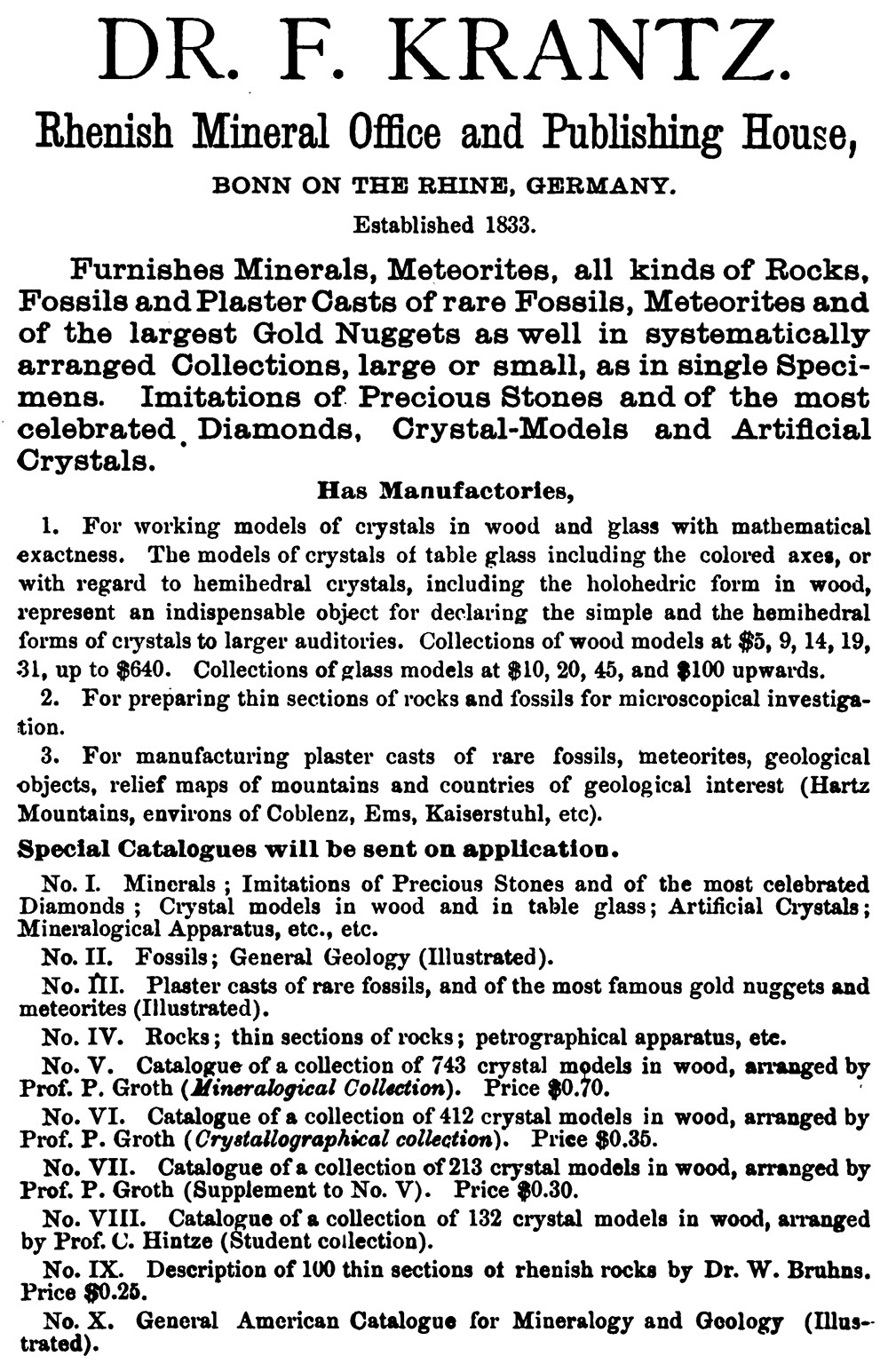
Figure 9.
An 1894 advertisement, from “The Naturalists’ Directory”.
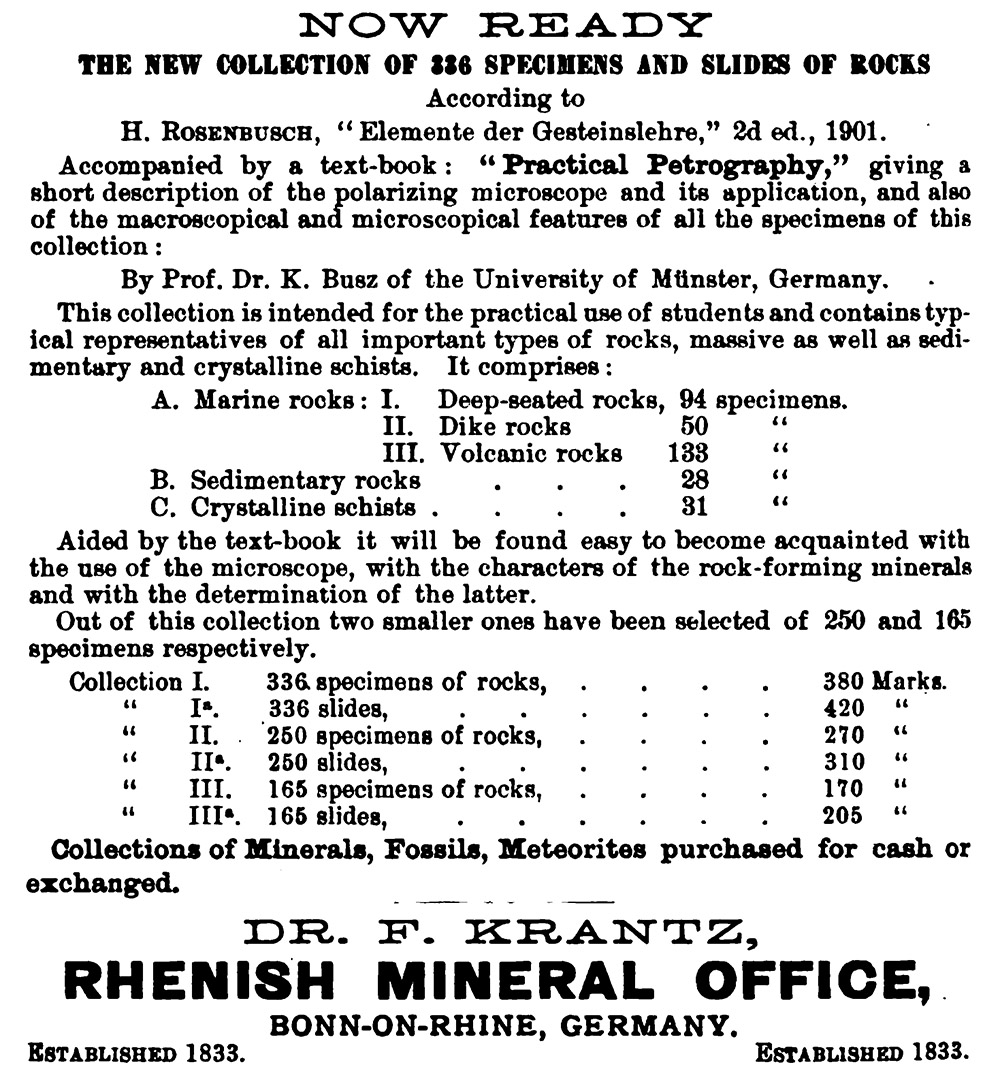
Figure 10.
A 1904 advertisement, from “The American Journal of Science”. Note that Krantz offered an extensive number of microscope slides.
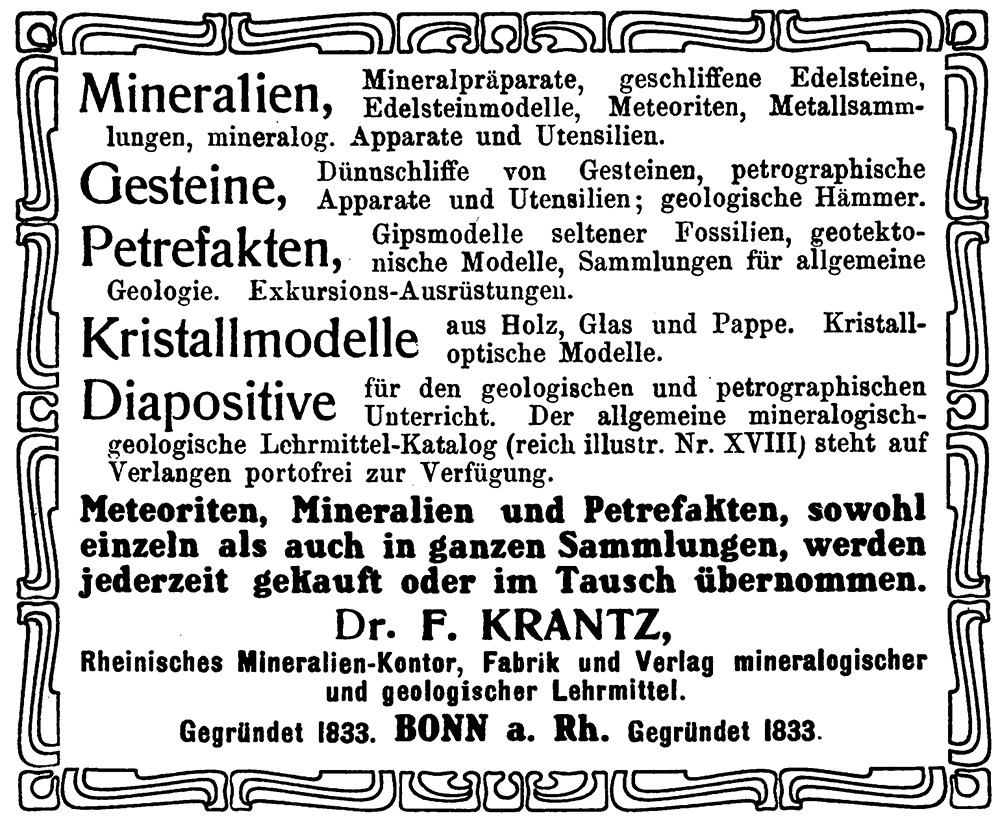
Figure 11.
A 1910 advertisement, from “Lotos”.

Figure 12.
Photomicrographs of the F. Krantz slide of Augitporphyrit (augite porphyry) shown in Figure 1, above. The same field was imaged using either normal transmitted light (left) or transmitted light with crossed polarizing filters below and above the specimen. Photographed with a C-mounted digital SLR camera and a 3.5x objective lens.
Resources
The American Journal of Science (1904) Advertisement from Dr. F. Krantz, Vol. 18
The Athenæum (1851) Advertisement from August Krantz, page 1
Chudoba, Karl F. (1972) Hintze, Carl, Neue Deutsche Biographie, 9, https://www.deutsche-biographie.de/pnd11689864X.html#ndbcontent
Geological Magazine (1872) Obituary of August Krantz, Vol. 9, page 240
Krantz web site, history (accessed September, 2018) https://www.krantz-online.de/en/ueber_uns/historie.html
Krantz, Friedrich (1909) Practical Petrography: Description of the Polarizing Microscope and of a Collection of 336 Rocks and Slides According to Elemente Der Gesteinslehre, Rhenish Mineral Office, Bonn
Lotos (1910) Advertisement from Dr. F. Krantz, Vol. 56, several issues
The Naturalists' Directory (1890) page 44, S.E. Cassino, Boston
The Naturalists' Directory (1894) Advertisement from Dr. F. Krantz, S.E. Cassino, Boston, rear of the book
The Naturalists' Directory (1896) page 61, S.E. Cassino, Boston
Nature (1894) Advertisement from Dr. F. Krantz, Vol. 50, August 2 issue, page cix
Nature (1908) Advertisements from Dr. F. Krantz, Vol. 77, numerous issues
The Scientists' International Directory (1892) page 91, S.E. Cassino, Boston
Spencer, L.J. (1928) Biographical notices of mineralogists recently deceased, The Mineralogical Magazine and Journal of the Mineralogical Society, Vol. 21, pages 239-240
Wilson, Wendell E. (acccessed September, 2018) A. and F. Krantz (1833 - ), The Mineralogical Record, https://mineralogicalrecord.com/labels.asp?colid=129











